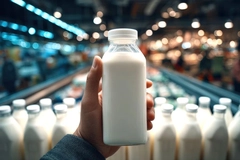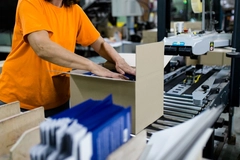Ice cream packaging innovation: Highlights in bio-based solutions and flexographic printing advances
14 Aug 2024 --- At the melting pot of sustainability and indulgence, the ice cream sector is advancing its green claims in packaging innovation. Featuring insights from Huhtamaki, Metsä Group and Berry Global Group, Packaging Insights examines the latest advances in bio-based cartons with water-based barrier coating, alongside innovations in flexographic printing.
“There is a growing demand for sustainable packaging alternatives — the key requests are around recyclability, material reduction and differentiation,” Herwin Wichers, global head new business, FMCG Category at Huhtamaki, tells us.
“Some demands are also requiring a step further in sustainability, such as renewable sources and compostability. Another trend is the enhanced consumer experience; packaging designs are becoming more attractive and functional, incorporating features like easy-open lids and single-serve options to cater to changing consumer behaviors,” he shares.
“Sometimes we get requests around activations or promotional activities, new concepts and new features to support ice-cream innovation and trends in frozen desserts.”
Huhtamaki’s Icon packaging
Huhtamaki-cited data reveals the global ice cream packaging market size is projected to grow from US$831.98 million in 2022 to an estimated US$1.3 billion by 2032, with a compound annual growth rate (CAGR) of 4.7% from 2023 to 2032.
Berry Global Group developed single-serve, freezer-grade Twist pints for Blue Bunny (Image credit: Blue Bunny).Meanwhile, Innova Market Insights data indicates that Dessert & Ice Cream launches were increasing globally, featuring a 12% year-over-year growth between April 2022 to March 2024.
“Our solutions are sustainability-driven and can be provided from different technologies, such as folding cartons, paperboard forming, flexibles, micro-corrugated boards and smooth molded fiber,” details Wichers.
“We’ve developed solutions with less plastic, packaging made from renewable materials, recyclable items as well as solutions that can reduce carbon footprint. Besides that, we’ve also made our range wider, with different shapes, such as non-round paper tubs and lids, domed smooth molded fiber lids and there are more to come in terms of materials innovation, technologies and decorations,” details Wichers.
Huhtamaki offers its Icon packaging solution, a recyclable ice cream pack made from 95% renewable bio-based material. Icon combines Huhtamaki’s proprietary water-based barrier coating with SFI-certified paperboard.
“Icon ice cream packaging shows that we can transition to paper-based packaging formats and alternative sustainable barriers without compromising packaging functionality, such as structural integrity in frozen supply chains,” says Wichers.
“[Icon packaging] combines renewable resources with advanced barrier coatings and we are also looking into fully recyclable and compostable materials, including paper-based solutions and biodegradable plastics,” he explains.
“By innovating and paying attention to key factors like condensation resistance, we have shown how paper-based materials can provide viable alternatives to plastic. The Icon packaging also includes a QR code that directs consumers to information about the sustainability benefits of the packaging, enhancing consumer engagement and education.”
Huhtamaki currently supplies paper and smooth molded fiber cups and lids, flexible flow wraps, and cone sleeves, paper tubs, paper squeezes, solutions with assembled cutlery, sealing membranes, bulk packaging, among other solutions in ice cream packaging.
“In some cases, we can also supply the in-house assembling systems for further optimization in the full chain,” adds Wichers.
Berry’s services a “new twist on soft serve”
Berry Global Group worked with US-based ice cream manufacturer, Wells Enterprises, to expand its Twist Cones frozen treat line into single-serve, freezer-grade Twist pints for Blue Bunny.
The new pints, which offer a new twist on soft serve, are currently available at retailers across the US, including Walmart, Kroger, Food Lion, Albertson’s, Safeway and Publix.
Made with widely recyclable PP and a high-density PE lid, the new Twist pints improve the recyclability of traditional ice-cream packaging, which is generally made of plastic-lined, paper board.
Metsä Board’s Twisty Ice Cream Boxex (Image credit: Metsä Board).The pints are also designed for nestability during transportation and storage, minimizing wasted space during transportation. This helps optimize supply chain efficiency and lessen the need for truckload shipments.
Similar to the custom 48-ounce PP containers produced by Berry for Blue Bunny’s scoopable ice cream line, these translucent pints allow consumers to appreciate the uniquely layered contents inside.
The pints come in seven soft serve flavors, including Chocolate Vanilla, Strawberries & Cream, Cookies & Cream, Candy Bar, Mint Chocolate, Blu’s Birthday Cake and Cherry Chocolate.
“Now more than ever, the ability to access innovative, recyclable packaging is crucial for our customers, as they strive to meet evolving sustainability demands,” Matt Chase, director of sales, national accounts at Berry Global.
“Through strong value-chain partnerships such as these, we are designing products more effectively to foster cleaner communities for future generations without compromising on convenience or shelf appeal.”
Metsä Board’s printing
In May, Metsä Board’s Twisty Ice Cream Boxes took home the “2024 Excellence” recognition in the Flexography Award’s Self Promotion Category, a ceremony catering to the flexographic industry in the US.
The team included packaging designers at Futupack, packaging manufacturer Adara Pakkaus, flexo printing plates supplier Marvaco, ink supplier Siegwerk and ECG printing specialist Dr. Kai Lankinen, who consulted on the project.
The team investigated different stages of the value chain, ranging from material production to ink usage and logistics, showcasing new possibilities using carefully selected lightweight fresh fiber materials and flexographic printing methods to achieve “excellent” usability and “unparalleled” halftone graphics in extreme high 188 lpi print resolution.
Metsä Board’s double coated white-top kraftliner (MetsäBoard Prime WKL, 125 g/m2) was selected as the top liner for its lightweight and smooth surface that enables excellent reproduction of detailed visuals.
The inside liner and fluting were made from uncoated kraftliner (MetsäBoard Natural WKL Bright 90 g/m2), which is ideal for small and lightweight packaging requiring high strength. Both materials are made from pure and traceable fresh wood fiber, making the packaging easily recyclable or compostable and safe for food packaging.
Having two layers from the same material also simplified production without compromising quality, highlights Metsä Board. Attention was also paid to minimize ink usage while keeping variety recognizable. Process printing was selected as the printing method to eliminate spot colors and enhance efficiency and flexibility.
The easy-to-open design eliminates the need for plastic parts or special tools for opening. Choices made at different stages also impact the packaging carbon footprint, notes Metsä Board.
The judges of the competition comment: “This promotional piece has a high degree of difficulty. It has an outstanding colored print, using just four colors.”
“This project showcased the power of seamless teamwork to achieve excellent functionality and resource efficiency. By combining our material expertise and design knowledge with a wide partner network, we were able to produce an innovative solution and superior quality in corrugated post-printing,” concludes Metsä Board’s packaging services director, Ilkka Harju.
By Benjamin Ferrer












